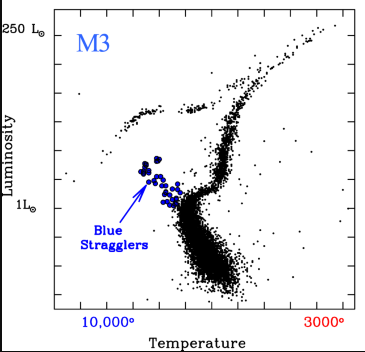Science & Technology
Blue Straggler Stars
- 04 Sep 2021
- 4 min read
Why in News
Recently, in the first-ever comprehensive analysis of blue stragglers, Indian researchers have proposed a hypothesis for evolution of blue straggler stars.
- Blue stragglers is a class of stars on open or globular clusters that stand out as they are bigger and bluer than the rest of the stars.
Key Points
- About Blue Straggler Stars:
- These are unusually hot and bright stars found in the cores of ancient star clusters known as globulars.
- A clue to their origin is that they are only found in dense stellar systems, where distances between stars are extremely small (a fraction of a light year).
- Allan Sandage (an astronomer with Carnegie Observatories in Pasadena, California) discovered blue stragglers in the globular cluster M3 in 1952-53.
- Most are located at least several thousand light-years away from the sun, and most are around 12 billion years old or more.
- The Milky Way's largest and brightest globular is Omega Centauri.
- Peculiarity about Blue Stragglers:
- Blue straggler stars appear to violate standard theories of stellar evolution.
- A bunch of stars born at the same time from the same cloud form a star cluster. Star formation happens in interstellar molecular clouds: opaque clumps of very cold gas and dust.
- Under standard stellar evolution, as time passes, each star evolves differently depending on its mass, in which all stars born at the same time should lie on a clearly defined curve in the Hertzsprung-Russell diagram.
- Hertzsprung-Russell diagram plots the temperature of stars against their luminosity or the colour of stars against their absolute magnitude. It shows a group of stars in various stages of their evolution.
- By far the most prominent feature is the main sequence, which runs from the upper left (hot, luminous stars) to the bottom right (cool, faint stars) of the diagram.
- In case of blue straggler, they evolve and move off the main sequence creating a bend in their track, known as the turnoff.
- Since blue stragglers often lie well off this curve, they may undergo abnormal stellar evolution.
- They appear to be lagging behind most of the other stars in the cluster in its evolution toward a cooler, reddish state.
- Blue straggler stars appear to violate standard theories of stellar evolution.
- About the Hypothesis:
- Indian researchers have found that:
- Half of the blue stragglers are formed through mass transfer from a close binary companion star.
- One third are likely formed through collisions of two stars.
- Remains are formed through interactions of more than two stars.
- For this Hypothesis, the researchers utilised the Gaia telescope of the European Space Agency.
- For further study, Ultraviolet Imaging Telescope on AstroSat, India’s first dedicated space observatory, as well as the 3.6 m Devasthal Optical Telescope in Nainital will be used.
- The study will help improve understanding of these stellar systems to uncover exciting results in studies of large stellar populations, including galaxies.
- Indian researchers have found that:







